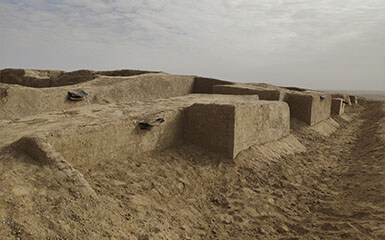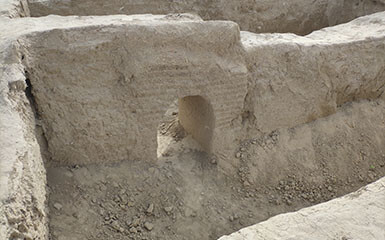Ashgabat
Alem Ferris wheel
State Museum
Fine Arts museum
Wedding Palace
Nisa fortress
Memorial Complex
Ertogrul Gazi Mosque
Neutrality monument
Independence Park
Turkmenbashi Ruhy Mosque
Olympic Village
Ylham Alley
Carpet Museum
Monument of Lenin
Ahal Region
Abivert
Altyn Depe
Annau
Darvaza
Geokdepe
Kowata
Mane baba
Zengi baba
Nedir Shah
Nokhur
Parzdepe
Sarahs baba
Seyit Jemaleddin mosque
Shahrislam
Ulug depe
Mary region
40 cupolas
Akcha Kala
Ancient Merv
Badkhyz
Chilburj
Gebeklytepe
Geok Gumbaz
Gurtly Depe
Kharoba Koshuk
Talkhatan Baba
Yekedeshik
Dashoguz region
Ashyk Aydyn Pir
Devkeshen
Ismamit ata
Kalaly-gyr
Kaplankyr Nature Reserve
Kunya-Urgench
Damla
Balkan region
Dehistan
Yangikala
Awaza
Gozli ata
Kemal ata
Mashat ata
Paraw bibi
Lunar Mountains
Shevlan Baba
Igdy kala
Ulug Depe - place that unites civilizations

Ulug Depe is an ancient site dating to the Bronze Age, located at the foot of the Kopet Dag, in Kaka District (Kaahka) of the Ahal province of south-eastern Turkmenistan. It covers an area of about 13 hectares, lies on a mound about 30 meters high, and documents the longest stratigraphic range in Central Asia from the Late Neolithic period represented by the Jeytun culture to the pre-Achaemenid period.
Located near Dushak, Ulug Depe in the early Bronze Age was a thriving agricultural town located in a fertile region on the northern slopes of the Kopet Dag. In the late 1960s, Soviet archaeologist Victor Sarianidi documented the importance of Ulug Depe as it shows a settlement that lasted from the Neolithic period (6th millennium BC) to the Achaemenid period (1st millennium BC). As considering its location, is regarded as an important centre in terms of documenting the interaction between Central Asia, Elamite, Mesopotamia and the Indus Civilization.
An important finding is a fortified mudbrick castle with buttress walls that dominates the lower part of the ancient city dating to the lower Achaemenid period. A study was initiated in 2004 to uncover remains of the settlement of this site, which produces figurines and other clay objects. Archaeologists have discovered a number of geometric ornaments and stone figures, along with depictions of the fertility goddess. They also discovered ancient grape seeds that reveal a lot about the great settlement system of ancient farmers living at the foot of the Kopet Dag, including other settlements such as Gara Depe, Namazga Depe, Altyn Depe, and Yylan Depe. During the excavations in the Late Bronze layers, a "pressure set" was also found to make the soma drink. This set is similar to those found on Gonur Depe. The artefacts discovered in Ulug Depe are exhibited in White Wheat Museum in Ashgabat.
The research conducted by the French team in 2007 revealed several main stages of the settlement at Ulug Depe. Other sherds were found, including vases from the chronological periods Namazga III and Namazga IV.

